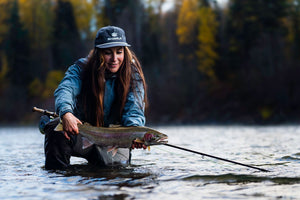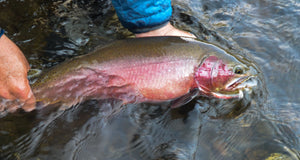How a tragic natural disaster created a once-in-a-lifetime fishing opportunity.
By Gardner Imhoff
Between June 10 and 13, 2022, the Yellowstone River and its surrounding tributaries wreaked havoc on my community and other nearby towns. The torrent swept away bridges, ripped homes off their foundations, inundated farms and ranches, and destroyed highways. Specifically, the floodwaters completely demolished the road that normally admits millions of annual visitors to the North Entrance of Yellowstone National Park. The carnage flooded social media feeds and international news reports for a couple of days. But as the waters receded, so did the attention. Over a month and a half after the flood, the media has moved on, yet our community continues to assess how we will recover from this 1 in 500-year event. Right now, we’re doing a lot of fishing.
In a normal summer, the small town of Gardiner, Montana, which sits just over the Northern border of Yellowstone National Park, gets inundated with tourists sporting floppy hats and sunburns. They spew from coach buses led by interpreters, buying cheesy t-shirts and cheap trinkets to mark their trips to Yellowstone. They stomp up every river and creek, whipping up wind knots and the occasional cutty. But this year, you’re more likely to run into a herd of elk on Gardiner’s Main St. than you are a group of tourists clad in jorts and socks with sandals. Though ominous and hard on the local economy, this year presents a nearly unheard-of opportunity for anglers.
A typical morning at the North Entrance of Yellowstone National Park.
Each spring high elevation snowfields melt and the Yellowstone River begins to rise. This is normally a cause for celebration around here. Fish like water, and so do we. In our semi-arid environment, we don’t take a drop for granted. We cheered when the snowpack rose above 200 percent—buying rounds at the bar, posting expectant Instagram stories, and penning hopeful fishing reports. Little did we know that this year would bring something we never imagined: too much water. Torrential rain in the Absaroka-Beartooth Mountain range and Yellowstone National Park sent a potent cocktail of snowmelt and rainwater into the upper Yellowstone River and its tributaries. Yellowstone National Park saw nearly 3 times the average rainfall for the entire month of June fall in just 3 days. The Yellowstone River hit a record estimated volume of 55,000 cubic feet per second (cfs)—over 20,000 cfs more than the previous record.
Gardiner consists of shops, hotels, lodges, restaurants, saloons, and outfitters that survive on the summer tourist traffic. It’s home to rugged Montana cowboys and ranchers who have worked the land outside of YNP for generations. It’s also home to us, river folk who chase whitewater or fish on the local rivers. Summer is normally the time of plenty, a time to stock the larder in order to endure the harsh winter months of the greater Yellowstone ecosystem.
An overhead view of Gardiner, MT in peak season.
The June floods sent Gardiner’s economy into a downward spiral. Data collected by YNP, show that the nearly 4-million visitors to the park in 2019 supported an estimated 7,000 jobs and contributed up to $640 million to towns outside of YNP. In an ordinary year, millions of visitors pass through Gardiner. Lines of cars reach beyond the famous Roosevelt Arch and the stores and restaurants fill with tourists eager to refuel after long days navigating bison jams and run ins with grizzly bears. Not this year. Local businesses continue to receive cancellation after cancellation as visitors change their summer plans following the closure of The Park’s North Entrance, but Gardiner has rebounded and remains open for business.
Guides and outfitters, like Yellowstone Fly Fishing Co., are allowed to enter Yellowstone’s closed North Entrance in order to take clients fishing. That means they can get to rivers that anglers coming from other parts of the park have to drive hours to access. Gardiner is nestled into one of the most beautiful and biodiverse areas in the lower-48, and no one is there. A day of fishing in YNP could be the best day you never knew you could have after the devastation we all witnessed.
So, load up your trucks, pack your coolers and fly boxes, and get your ass to Gardiner. The opportunity to have the Upper Yellowstone River and its surrounding fisheries virtually to yourself won’t last. The guides are waiting, the beer is cold, and the fish are eating dry flies. By next season, Gardiner will be once again be bustling, the rivers crowded, the boat ramps full. This is the season to fish the Upper Yellowstone and the northeast corner of Yellowstone National Park.



